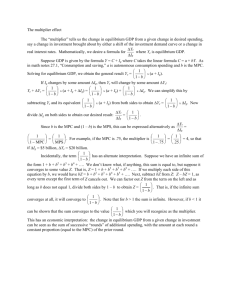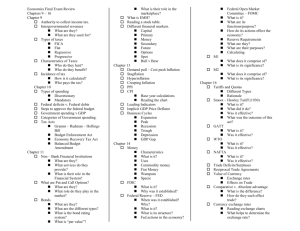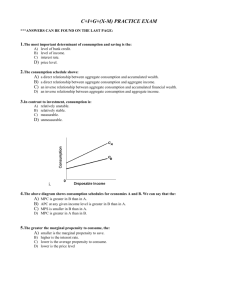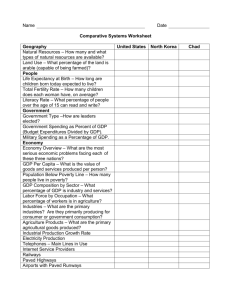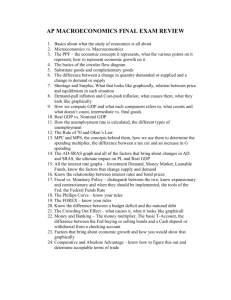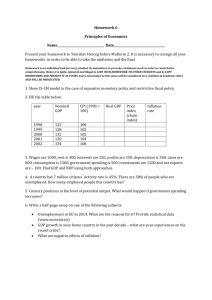File - Mr. Sandersen
advertisement
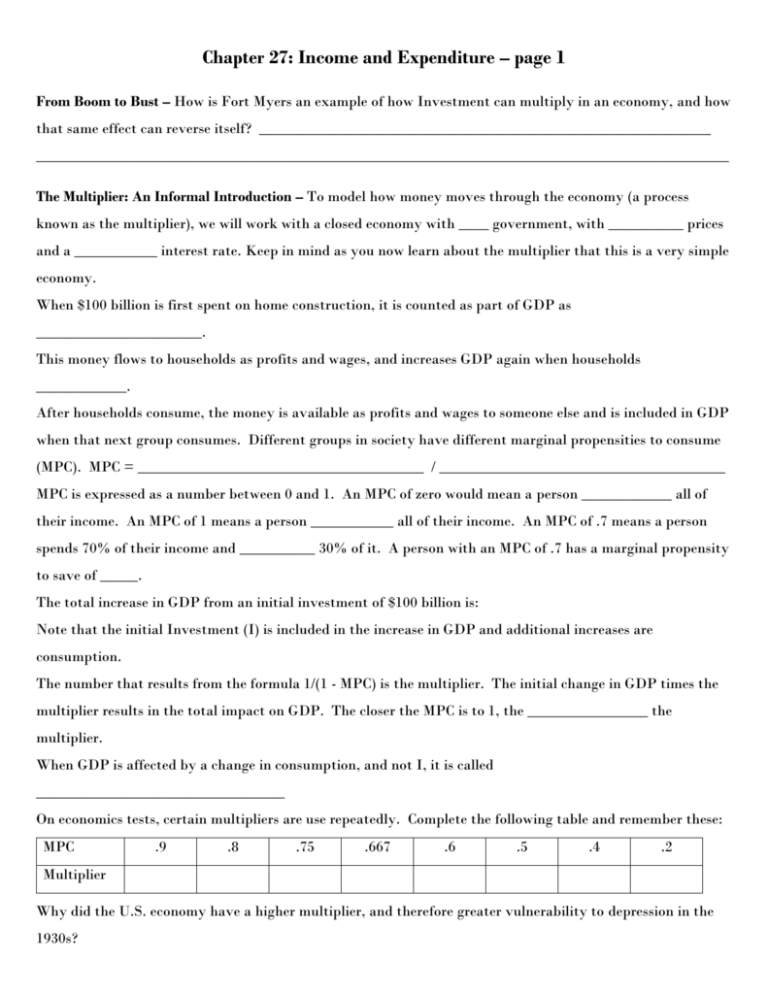
Chapter 27: Income and Expenditure – page 1 From Boom to Bust – How is Fort Myers an example of how Investment can multiply in an economy, and how that same effect can reverse itself? ____________________________________________________________ ____________________________________________________________________________________________ The Multiplier: An Informal Introduction – To model how money moves through the economy (a process known as the multiplier), we will work with a closed economy with ____ government, with __________ prices and a ___________ interest rate. Keep in mind as you now learn about the multiplier that this is a very simple economy. When $100 billion is first spent on home construction, it is counted as part of GDP as ______________________. This money flows to households as profits and wages, and increases GDP again when households ____________. After households consume, the money is available as profits and wages to someone else and is included in GDP when that next group consumes. Different groups in society have different marginal propensities to consume (MPC). MPC = ______________________________________ / ______________________________________ MPC is expressed as a number between 0 and 1. An MPC of zero would mean a person ____________ all of their income. An MPC of 1 means a person ___________ all of their income. An MPC of .7 means a person spends 70% of their income and __________ 30% of it. A person with an MPC of .7 has a marginal propensity to save of _____. The total increase in GDP from an initial investment of $100 billion is: Note that the initial Investment (I) is included in the increase in GDP and additional increases are consumption. The number that results from the formula 1/(1 - MPC) is the multiplier. The initial change in GDP times the multiplier results in the total impact on GDP. The closer the MPC is to 1, the ________________ the multiplier. When GDP is affected by a change in consumption, and not I, it is called _________________________________ On economics tests, certain multipliers are use repeatedly. Complete the following table and remember these: MPC .9 .8 .75 .667 .6 .5 .4 .2 Multiplier Why did the U.S. economy have a higher multiplier, and therefore greater vulnerability to depression in the 1930s? ____________________________________________________________________________________________ CYU 27-1, 1. __________________________________________________________________________________ 3. __________________________________________________________________________________________ p. 727, problem 1. Westlandia’s total change in real GDP = _________________ Eastlandia’s _________________ 2. a. ___________________________ b. _____________________________ c. ____________________________ Consumer Spending – The formula that reveals the relationship between an individual’s disposable income and consumption is called the ____________________ _____________________. c = ___ + _______ * _______ The letters a, c and yd are all lower case in this formula because ________________________________________. The letter ‘a’ stands for ________________ ___________________ _________________. This number reveals that even if a person has no source of disposable income, they still must spend something, either by _____________ or drawing from _____________________. The consumption function is an _________________ sloping line that does not start at zero on the y-axis, but rather at ____. The slope of that line is the individual’s _________. Along that line is the level of ________________ the individual does at increasing levels of _____________ ___________. The best estimate of ‘a’ in our society is _______________ and the best estimate of MPC is ________________. The consumption function for all of society is called the ________________ _________________ _____________. When there is more spending in society, this curve will shift ____. When there is less, this curve will shift _______. CYU 27-2, 1. a. Angelina - _________________ Felicia - __________________ Marina _____________________ Prob. 3.a. Write each person’s consumption function: Andre-__________________ Barbara__________________ Casey - _________________________ Daclan - _________________________ Elena _____________________ 4. Start this problem by calculating MPC… change in C / change in YD. Calculate ‘a’ by using zero as base YD. b. MPC = ____________ MPS = ______________ c. Agg. Consumption function - _______________________ Shifts of the Aggregate Consumption Function – Why does the aggregate consumption function shift based on a change in expected future disposable income? _______________________________________________________ ____________________________________________________________________________________________ How do changes in aggregate wealth lead to shifts in the function? ______________________________________ ____________________________________________________________________________________________ CYU 27-2, 2. _________________________________________________________________________________ Investment Spending – In recent recessions, which has dipped more drastically, C or I? __________________ Planned investment spending is defined as ________________________________________________________. Note that planned Investment is not always equal to actual investment. Actual investment is what is recorded as I. The Interest Rate and Investment Spending – What area of I is particularly sensitive to r? ____________________ In all sectors of the economy, I is lower when r is ______________. This is even the case when companies are investing with retained earnings. Why? ____________________________________________________________ Expected Future Real GDP, Production Capacity, and Investment Spending - Other things equal, if future sales are expected to be high, I will ________________. If current production capacity is high, I will _______________. Inventories and Unplanned Investment Spending – What is inventory and what is its purpose? ________________ ________________________________________________________ Is inventory a big part of the economy? ____ Inventory investment is _________________________________________________. Inventory investment can be ____________________ in a given period if sales are particularly _________________. If sales were constant and predictable, inventory investment would be _________. Since sales fluctuate, there is unplanned inventory I. (to be contd.) Chapter 27: Income and Expenditure – page 2 Inventories and Unplanned Investment Spending – Actual investment spending is represented by the letter ____. Actual investment = I ______________ + I _____________. Which one of these can be negative? I ___________ If there is positive unplanned inventory investment one year, we expect I to ____________________ the next year. If there is negative unplanned inventory investment one year, we expect I to ____________________ the next year. Economics in Action: Interest Rates and the U.S. Housing Boom – The recent U.S. housing boom was fed by low ___________ _________. This helped builders borrow to invest and helped home buyers __________________. CYU 27-3, 1. a. ___________________ b. ___________________ c. __________________ d. _________________ 2. __________________________________________________________________________________________ 3. __________________________________________________________________________________________ 7. a. ____________________________ b. ____________________________ c. ____________________________ 8. a. ____________________________ b. ____________________________ c. ____________________________ The Income-Expenditure Model – Inventory levels help economists understand the current state of the economy and understand the likely _______________ state of the economy. We will now model this with a positive correlation between spending and output, no G, fixed r, and no net X. You will be happy it is simplified. Planned Aggregate Spending and Real GDP - In a simplified, closed economy GDP = ____ + ____ = _______ The aggregate consumption function is: The formula for planned aggregate spending is: Since planned inventory is fixed, planned aggregate spending will increase as GDP and YD increase. Table 273 shows us that as YD increases, planned aggregate spending increases by the increase in ______________, or ____, which is change in YD * ________. The difference between AEplanned and GDP is going to be I _______________. In row 3 of table 27-3, Iunplanned =-400. This means that of the 900 of consumption, 400 was not produced previously. On a graph, CF and AEplanned are ___________________ lines separated by the value of I ___________________. There is only one point on this graph at which ________ ______ equals AE ________________. This point is called ___________-______________ __________________. Over time, the economy moves toward equilibrium. Please remember that you’re not supposed to love this. If you love this, you’re strange. It’s part of what you have to know to fully understand how the economy works. I encourage you to think hard and try and sort it out. If you do, you will have more earning potential and time for more vacation, which you will hopefully enjoy more than this! Income-Expenditure Equilibrium – When real GDP is greater then AEplanned …oops! Companies have produced products that they are unable to ________. What is likely to happen to Iplanned next year? ___________________ Put it all together: GDP = ___ + ___ = ___ + __________ + ____________ = ___________ + _____________ When GDP is > AEplanned , Iunplanned is ______________, and when GDP is < AEplanned , Iunplanned is ______________. When GDP is > AEplanned , firms will _______________ ___________________ in the future. When GDP is < AEplanned , firms will _______________ ______________________. This is one big insight of the chapter. Seize it. The only time firms will not adjust future production is when __________________________________________. The symbol for income-expenditure equilibrium GDP is _________. You’re a star when real GDP = AEplanned!!! In the income-expenditure model (27-9), ________ ______ is on the x-axis (Q as always) and ________ _________ ____________ is on the y-axis (it’s not really a P…deal with it.) This model has two lines on it. One is a ____º line. On this line, y = 1x + 0. The slope is ____ and the y-intercept is ____, so y = x, or real GDP = ________________. The other line represents AE ___________ at different levels of YD, or real GDP. In a y = mx + b format, this line is y = MPCx + (A + I__________). The slope is ______ and the y-intercept is ____________________________. To the left of equilibrium, AE ________ > real GDP, so I_________ is negative. GDP is expected to _____ later. To the right of equilibrium, AE _______ < real GDP, so I________ is positive. GDP is expected to ______ later. I-E equilibrium is known as the ______________ ___________. The religious undertones are awkward to Mr. S. The Multiplier Process and Inventory Adjustment – Changes in inventory are considered a _______________ ____________ of future economic activity. Note that leading happens before, and lagging indicators happen after. The onset of ch. 27 was a leading indicator of your boredom. The bleary look on your eyes in period 5 is ________. The two possible sources of a shift of the planned aggregate spending line are _____________________________ ____________________________________________________________________________________________ When there is an autonomous increase in C, the AEplanned line shifts ____. Real GDP increases by _____________ __________________. Because of the multiplier effect, real GDP has increased more than the increase in ______. This is captured in the formula: What is the paradox of thrift? How does it trigger a negative multiplier effect? _____________________________ ____________________________________________________________________________________________ CYU 27-4. 1. _________________________________________________________________________________ 2. a. b. Prob. 9. b. ______________ c. ______________ d. _________________ e. ______________ f. _______________ 10. a. b. __________________ c.________________ d. __________________ e.________________ 11. a. ________________________________________________________________________________________ 12. b. ________________________________________________________________________________________ ____________________________________________________________________________________________
